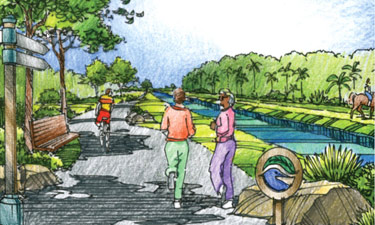 Miami-Dade County’s history teaches us that some of our greatest opportunities arise after downturns. Legacy parks such as Greynolds, Matheson Hammock, and Crandon Park, among others—are the direct result of our forefather’s active planning for the future. Their wise investment in what were then devalued properties and the labors of the Civilian Conservation Corps for the construction of parks and buildings produced the landmarks treasured today in Miami-Dade.
Miami-Dade County’s history teaches us that some of our greatest opportunities arise after downturns. Legacy parks such as Greynolds, Matheson Hammock, and Crandon Park, among others—are the direct result of our forefather’s active planning for the future. Their wise investment in what were then devalued properties and the labors of the Civilian Conservation Corps for the construction of parks and buildings produced the landmarks treasured today in Miami-Dade.
Like the generation of the 1930s, Miami-Dade today surveys a landscape of great needs. Armed with new understandings about the relationship between health and the environment, Miami-Dade County is seizing this opportunity to rescue devalued properties for new life as parks and neighborhood centers while simultaneously employing the design strategies we now know can restore the economic, environmental, and social well being of our community. Just as leaders in business and government partnered to create Miami Dade’s legacy parks, so too are Miami-Dade’s leaders taking action today.
Miami-Dade County is one of 12 regions in the country to partner with the national organization, City Parks Alliance, focusing on the transformation of vacant and financially distressed commercial properties into a sustainable landscape of parks, neighborhood centers and trails. The Miami-Dade Red Fields to Green Fields initiative identifies properties that can be effectively rescued and returned to the ecosystem as part of Miami-Dade’s park system. The benefits expand across economic, health, and environmental impacts to revitalize neighborhoods and secure livable, walkable communities.
The Miami-Dade County Parks, Recreation and Open Spaces Department (MDPROS) is distinctively prepared for this challenge. County park planners spent 36 months in nearly 250 public meetings with more than 3,000 participants to develop a visionary Parks Master Plan that places a park, trail or recreational landscape within a one-quarter mile walk of every resident.
Through partnerships with various agencies MDPROS is promoting healthy lifestyles and increasing the community’s access to parks by eliminating barriers in the built environment that influence physical activity, obesity, and chronic disease. With the Health Department, they have developed access and equity strategies for parks, open space, and recreation programming policies; urban design manuals—walkability and active living standards to guide the design of private and public developments; countywide recreation facility and program inventory to assess gaps in the system and coordinate service delivery among 35 municipalities, state and federal agencies. With the University of Miami-Miller School of Medicine MDPROS is working to provide physical and nutritional evidenced-based recreation activities for children to improve their health and fitness. And in partnership with the South Florida Health Foundation and the Trust for Public Land, MDPROS is providing Enhanced Fitness programs for Seniors and implementing Fitness Zones (outdoor fitness equipment).
These are some of the critical partner agencies that form the Miami-Dade Red Fields to Green Fields interdisciplinary team of experts in parks, health, sustainability, real estate development and finance who have meshed the Miami-Dade master plan proposals with related, distressed commercial properties, and health and environment data to create an immediate action plan of specific, high-impact projects. From the Biscayne Everglades Greenway—a 42 mile multi-purpose trail that link communities in South Miami-Dade to Biscayne and Everglades National Parks, to local TOPS (Transit Oriented Parks) constructed around the stations and stops of existing and future transit lines, to parks in neighborhoods of health disparity, these projects rescue vulnerable places and restore economic, social and physical health, assure a future of environmental and economic sustainability to restore community health, put people to work and jump start the future.

